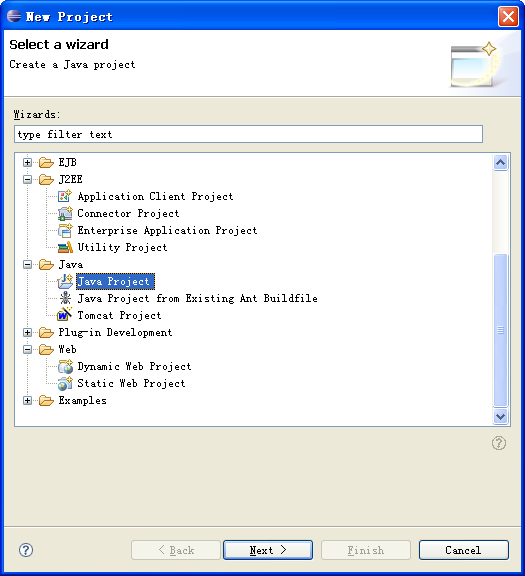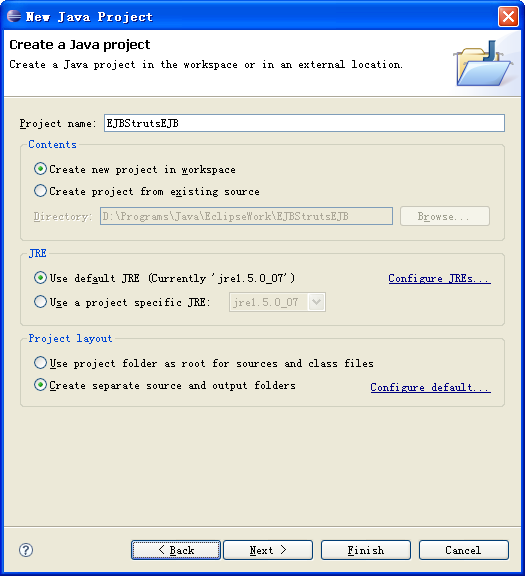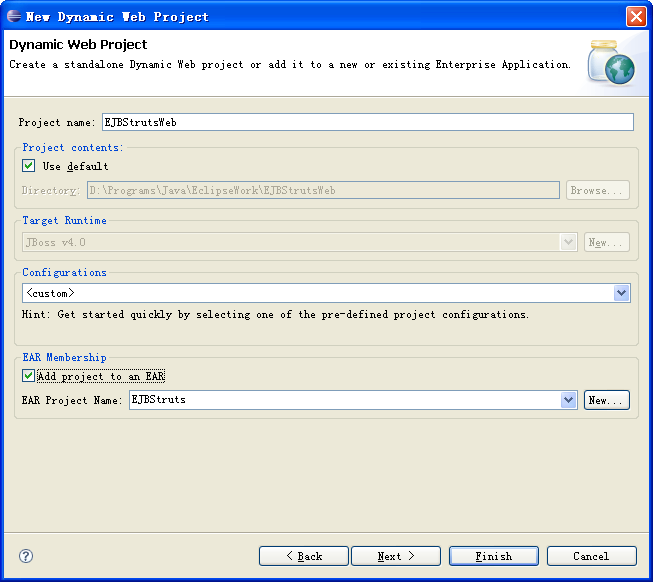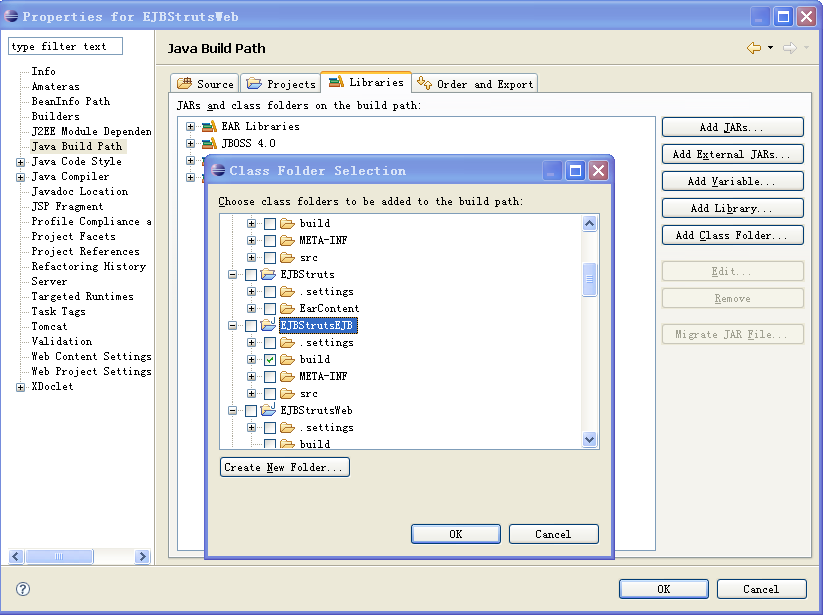EJB3.0 + Struts小試
一直想做一個 EJB3.0 結合 Struts 的例子,前天剛好從網上找到了一個相關的 Tutorial ,于是小試了一把,雖然只是完成了 Tutorial 上的一小點功能,但是感覺還是有必要寫下來,免得以后還要再去看別人的Tutorial 。
開發環境:??
??? Eclipse3.2 + WTP1.5 , JBoss 4.0.3SP1 , jboss-EJB-3.0_RC5-PFD,MySQL5.0.16
? 環境的搭建可以參考我的學習筆記:
??? EJB 3.0 學習筆記——準備工作 : http://www.aygfsteel.com/felicity/archive/2006/03/26/37510.html
??? EJB 3.0 學習筆記—— Entity Bean : http://www.aygfsteel.com/felicity/archive/2006/05/20/47229.html
??? 在MySQL? 中新建數據庫ejbstruts,在JBoss的all\deploy下新建ejbstruts-ds.xml,其內容如下:
<!-- ?$Id:?mysql-ds.xml,v?1.3.2.1?2004/12/01?11:46:00?schrouf?Exp?$? -->
<!-- ??Datasource?config?for?MySQL?using?3.0.9?available?from:
http://www.mysql.com/downloads/api-jdbc-stable.html?
--> ?
< datasources >
?? < local-tx-datasource >
???? < jndi-name > EJBStrutsDS </ jndi-name >
???? < connection-url > jdbc:mysql://localhost:3306/ejbstruts </ connection-url >
???? < driver-class > com.mysql.jdbc.Driver </ driver-class >
???? < user-name > test </ user-name >
???? < password ></ password >
???? < exception-sorter-class-name > org.jboss.resource.adapter.jdbc.vendor.MySQLExceptionSorter </ exception-sorter-class-name >
???? <!-- ?sql?to?call?when?connection?is?created
????<new-connection-sql>some?arbitrary?sql</new-connection-sql>
?????? -->
???? <!-- ?sql?to?call?on?an?existing?pooled?connection?when?it?is?obtained?from?pool?
????<check-valid-connection-sql>some?arbitrary?sql</check-valid-connection-sql>
?????? --> ?
???? <!-- ?corresponding?type-mapping?in?the?standardjbosscmp-jdbc.xml?(optional)? -->
???? < metadata >
??????? < type-mapping > mySQL </ type-mapping >
???? </ metadata >
?? </ local-tx-datasource >
</ datasources > ?
新建工程:
?最后的程序會打包成一個EAR部署到JBoss,所以在Eclipse中創建三個新的工程:
??1、EAR Project:EJBStruts???????

選好 Target Runtiem為 JBoss后Finish。

?2、Java EJB3 Project: EJBStrutsEJB
由于WTP1.5還不支持EJB3.0的直接創建,這里新建的是一個普通的Java Project,之后會用ant來創建ejb jar。
由于是普通的Java Project,之后直接Finish好了。
?3、? WEB Project:EJBStrutsWeb
這里可以將工程添加到前面建好的EAR中。
EJB模塊
向EJBStrutsEJB工程中導入User Library:EJB3_JBoss
新建兩個EJB Entities:Book 和Customer
?*?Book.java
? */
package ?com.lzy.library.domain;
import ?java.io.Serializable;?
import ?javax.persistence.Column;
import ?javax.persistence.Entity;
import ?javax.persistence.GeneratedValue;
import ?javax.persistence.GenerationType;
import ?javax.persistence.Id;
import ?javax.persistence.JoinColumn;
import ?javax.persistence.ManyToOne;
import ?javax.persistence.Table;?
@Entity
@Table(name? = ? " BOOK " )
public ? class ?Book? implements ?Serializable?{
? /**
??*?
?? */
? private ? static ? final ? long ?serialVersionUID? = ? 1L ;?
? private ?Integer?id;?
? private ?String?title;?
? private ?String?author;?
? private ?Customer?customer;?
? public ?Book()?{
?? super ();
?}?
? public ?Book(Integer?id,?String?title,?String?author)?{
?? super ();
?? this .id? = ?id;
?? this .title? = ?title;
?? this .author? = ?author;
?}?
?@Column(name? = ? " AUTHOR " )
? public ?String?getAuthor()?{
?? return ?author;
?}?
? public ? void ?setAuthor(String?author)?{
?? this .author? = ?author;
?}?
?@Id
?@GeneratedValue(strategy? = ?GenerationType.AUTO)
?@Column(name? = ? " ID " )
? public ?Integer?getId()?{
?? return ?id;
?}?
? public ? void ?setId(Integer?id)?{
?? this .id? = ?id;
?}?
?@Column(name? = ? " TITLE " )
? public ?String?getTitle()?{
?? return ?title;
?}?
? public ? void ?setTitle(String?title)?{
?? this .title? = ?title;
?}?
?@ManyToOne
?@JoinColumn(name? = ? " CUSTOMER_ID " )
? public ?Customer?getCustomer()?{
?? return ?customer;
?}?
? public ? void ?setCustomer(Customer?customer)?{
?? this .customer? = ?customer;
?}?
?@Override
? public ?String?toString()?{
?? return ? " Book:? " ? + ?getId()? + ? " ?Title? " ? + ?getTitle()? + ? " ?Author? "
???? + ?getAuthor();
?}?
}
?
 /**?*/
/**
/**?*/
/**
 ?*?Customer.java
?*?Customer.java ?
*/
?
*/
 package
?com.lzy.library.domain;?
package
?com.lzy.library.domain;?
 import
?java.io.Serializable;
import
?java.io.Serializable; import
?java.util.ArrayList;
import
?java.util.ArrayList; import
?java.util.List;?
import
?java.util.List;?
 import
?javax.persistence.CascadeType;
import
?javax.persistence.CascadeType; import
?javax.persistence.Column;
import
?javax.persistence.Column; import
?javax.persistence.Entity;
import
?javax.persistence.Entity; import
?javax.persistence.FetchType;
import
?javax.persistence.FetchType; import
?javax.persistence.GeneratedValue;
import
?javax.persistence.GeneratedValue; import
?javax.persistence.GenerationType;
import
?javax.persistence.GenerationType; import
?javax.persistence.Id;
import
?javax.persistence.Id; import
?javax.persistence.OneToMany;
import
?javax.persistence.OneToMany; import
?javax.persistence.Table;?
import
?javax.persistence.Table;?

 /**?*/
/**
/**?*/
/**
 ?*?
@author
?rouserli
?*?
@author
?rouserli ?*
?* ?
*/
?
?
*/
?
 @Entity
@Entity @Table(name?
=
?
"
CUSTOMER
"
)
@Table(name?
=
?
"
CUSTOMER
"
)
 public
?
class
?Customer?
implements
?Serializable?
public
?
class
?Customer?
implements
?Serializable?
 {
{
 ?
/**?*/
/**
?
/**?*/
/**
 ??*?
??*? ??
*/
??
*/
 ?
private
?
static
?
final
?
long
?serialVersionUID?
=
?
1L
;?
?
private
?
static
?
final
?
long
?serialVersionUID?
=
?
1L
;?
 ?
private
?Integer?id;?
?
private
?Integer?id;?
 ?
private
?String?name;?
?
private
?String?name;?
 ?
private
?List?books?
=
?
new
?ArrayList();?
?
private
?List?books?
=
?
new
?ArrayList();?

 ?
public
?Customer()?
?
public
?Customer()?
 {
{ ??
super
();
??
super
(); ??
//
?TODO?Auto-generated?constructor?stub
??
//
?TODO?Auto-generated?constructor?stub
 ?}
?
?}
?

 ?
public
?Customer(Integer?id,?String?name)?
?
public
?Customer(Integer?id,?String?name)?
 {
{ ??
super
();
??
super
(); ??
this
.id?
=
?id;
??
this
.id?
=
?id; ??
this
.name?
=
?name;
??
this
.name?
=
?name; ?}
?
?}
?
 ?@Id
?@Id ?@GeneratedValue(strategy?
=
?GenerationType.AUTO)
?@GeneratedValue(strategy?
=
?GenerationType.AUTO) ?@Column(name?
=
?
"
ID
"
)
?@Column(name?
=
?
"
ID
"
)
 ?
public
?Integer?getId()?
?
public
?Integer?getId()?
 {
{ ??
return
?id;
??
return
?id; ?}
?
?}
?

 ?
public
?
void
?setId(Integer?id)?
?
public
?
void
?setId(Integer?id)?
 {
{ ??
this
.id?
=
?id;
??
this
.id?
=
?id; ?}
?
?}
?
 ?@Column(name?
=
?
"
NAME
"
)
?@Column(name?
=
?
"
NAME
"
)
 ?
public
?String?getName()?
?
public
?String?getName()?
 {
{ ??
return
?name;
??
return
?name; ?}
?
?}
?

 ?
public
?
void
?setName(String?name)?
?
public
?
void
?setName(String?name)?
 {
{ ??
this
.name?
=
?name;
??
this
.name?
=
?name; ?}
?
?}
?
 ?@OneToMany(cascade?
=
?CascadeType.ALL,?fetch?
=
?FetchType.EAGER,?mappedBy?
=
?
"
customer
"
,?targetEntity?
=
?Book.
class
)
?@OneToMany(cascade?
=
?CascadeType.ALL,?fetch?
=
?FetchType.EAGER,?mappedBy?
=
?
"
customer
"
,?targetEntity?
=
?Book.
class
)
 ?
public
?List?getBooks()?
?
public
?List?getBooks()?
 {
{ ??
return
?books;
??
return
?books; ?}
?
?}
?

 ?
public
?
void
?setBooks(List?books)?
?
public
?
void
?setBooks(List?books)?
 {
{ ??
this
.books?
=
?books;
??
this
.books?
=
?books; ?}
?
?}
?
 ?@Override
?@Override
 ?
public
?String?toString()?
?
public
?String?toString()?
 {
{ ??
return
?
"
Customer:?
"
?
+
?getId()?
+
?
"
?Name?
"
?
+
?getName();
??
return
?
"
Customer:?
"
?
+
?getId()?
+
?
"
?Name?
"
?
+
?getName(); ?}
?}
 }
}


在工程下新建
META-INF目錄,該目錄下新建persistence.xml文件。
 ?
<?
xml?version="1.0"?encoding="UTF-8"
?>
?
<?
xml?version="1.0"?encoding="UTF-8"
?>
 <
persistence
>
<
persistence
>
 ???
<
persistence-unit?
name
="test"
>
???
<
persistence-unit?
name
="test"
>
 ??????
<
jta-data-source
>
java:/EJBStrutsDS
</
jta-data-source
>
??????
<
jta-data-source
>
java:/EJBStrutsDS
</
jta-data-source
>
 ??????
<
properties
>
??????
<
properties
>
 ???????
<
property?
name
="hibernate.dialect"
?value
="org.hibernate.dialect.MySQLDialect"
/>
???????
???????
<
property?
name
="hibernate.dialect"
?value
="org.hibernate.dialect.MySQLDialect"
/>
??????? ????????
<
property?
name
="hibernate.hbm2ddl.auto"
?value
="update"
/>
????????
<
property?
name
="hibernate.hbm2ddl.auto"
?value
="update"
/>
 ??????
</
properties
>
??????
</
properties
>
 ???
</
persistence-unit
>
???
</
persistence-unit
>
 </
persistence
>
</
persistence
>


然后新建DAO接口BookDao(Local)和CustomerDao(Local),以及各自的實現BookDaoImpl(Stateless)和CustomerDaoImpl(Stateless),在后面的Web工程中,將通過這兩個DAO接口進行數據庫操作。由于這部分可供參考的例子很多,略去源碼。
新建文件builder.xml
 <?
xml?version="1.0"
?>
?
<?
xml?version="1.0"
?>
?
 <!--
?=======================================================================?
-->
<!--
?=======================================================================?
-->
 <!--
?JBoss?build?file???????????????????????????????????????????????????????
-->
<!--
?JBoss?build?file???????????????????????????????????????????????????????
-->
 <!--
?=======================================================================?
-->
?
<!--
?=======================================================================?
-->
?
 <
project?
name
="JBoss"
?default
="ejbjar"
?basedir
="."
>
?
<
project?
name
="JBoss"
?default
="ejbjar"
?basedir
="."
>
?
 ???
<
property?
file
="../local.properties"
?
/>
???
<
property?
file
="../local.properties"
?
/>
 ???
<
property?
environment
="env"
/>
???
<
property?
environment
="env"
/>
 ???
<
property?
name
="src.dir"
?value
="${basedir}/src"
/>
???
<
property?
name
="src.dir"
?value
="${basedir}/src"
/>
 ???
<
property?
name
="jboss.home"
?value
="E:/Programming/Servers/jboss-4.0.3SP1/"
/>
???
<
property?
name
="jboss.home"
?value
="E:/Programming/Servers/jboss-4.0.3SP1/"
/>
 ???
<
property?
name
="jboss.server.config"
?value
="all"
/>
???
<
property?
name
="jboss.server.config"
?value
="all"
/>
 ???
<
property?
name
="build.dir"
?value
="${basedir}/build"
/>
???
<
property?
name
="build.dir"
?value
="${basedir}/build"
/>
 ???
<
property?
name
="build.classes.dir"
?value
="${build.dir}/classes"
/>
?
???
<
property?
name
="build.classes.dir"
?value
="${build.dir}/classes"
/>
?
 ???
<!--
?Build?classpath?
-->
???
<!--
?Build?classpath?
-->
 ???
<
path?
id
="classpath"
>
???
<
path?
id
="classpath"
>
 ??????
<!--
?So?that?we?can?get?jndi.properties?for?InitialContext?
-->
??????
<!--
?So?that?we?can?get?jndi.properties?for?InitialContext?
-->
 ??????
<
pathelement?
location
="${basedir}"
/>
??????
<
pathelement?
location
="${basedir}"
/>
 ??????
<
fileset?
dir
="${jboss.home}/lib"
>
??????
<
fileset?
dir
="${jboss.home}/lib"
>
 ?????????
<
include?
name
="**/*.jar"
/>
?????????
<
include?
name
="**/*.jar"
/>
 ??????
</
fileset
>
??????
</
fileset
>
 ??????
<
fileset?
dir
="${jboss.home}/server/${jboss.server.config}/lib"
>
??????
<
fileset?
dir
="${jboss.home}/server/${jboss.server.config}/lib"
>
 ?????????
<
include?
name
="**/*.jar"
/>
?????????
<
include?
name
="**/*.jar"
/>
 ??????
</
fileset
>
??????
</
fileset
>
 ??????
<
fileset?
dir
="${jboss.home}/server/${jboss.server.config}/deploy/ejb3.deployer"
>
??????
<
fileset?
dir
="${jboss.home}/server/${jboss.server.config}/deploy/ejb3.deployer"
>
 ?????????
<
include?
name
="*.jar"
/>
?????????
<
include?
name
="*.jar"
/>
 ??????
</
fileset
>
??????
</
fileset
>
 ??????
<
fileset?
dir
="${jboss.home}/server/${jboss.server.config}/deploy/jboss-aop-jdk50.deployer"
>
??????
<
fileset?
dir
="${jboss.home}/server/${jboss.server.config}/deploy/jboss-aop-jdk50.deployer"
>
 ?????????
<
include?
name
="*.jar"
/>
?????????
<
include?
name
="*.jar"
/>
 ??????
</
fileset
>
??????
</
fileset
>
 ??????
<
pathelement?
location
="${build.classes.dir}"
/>
??????
<
pathelement?
location
="${build.classes.dir}"
/>
 ???
</
path
>
?
???
</
path
>
?
 ???
<
property?
name
="build.classpath"
?refid
="classpath"
/>
?
???
<
property?
name
="build.classpath"
?refid
="classpath"
/>
?
 ???
<!--
?===================================================================?
-->
???
<!--
?===================================================================?
-->
 ???
<!--
?Prepares?the?build?directory????????????????????????????????????????
-->
???
<!--
?Prepares?the?build?directory????????????????????????????????????????
-->
 ???
<!--
?===================================================================?
-->
???
<!--
?===================================================================?
-->
 ???
<
target?
name
="prepare"
>
???
<
target?
name
="prepare"
>
 ??????
<
mkdir?
dir
="${build.dir}"
/>
??????
<
mkdir?
dir
="${build.dir}"
/>
 ??????
<
mkdir?
dir
="${build.classes.dir}"
/>
??????
<
mkdir?
dir
="${build.classes.dir}"
/>
 ???
</
target
>
?
???
</
target
>
?
 ???
<!--
?===================================================================?
-->
???
<!--
?===================================================================?
-->
 ???
<!--
?Compiles?the?source?code????????????????????????????????????????????
-->
???
<!--
?Compiles?the?source?code????????????????????????????????????????????
-->
 ???
<!--
?===================================================================?
-->
???
<!--
?===================================================================?
-->
 ???
<
target?
name
="compile"
?depends
="prepare"
>
???
<
target?
name
="compile"
?depends
="prepare"
>
 ??????
<
javac?
srcdir
="${src.dir}"
??????
<
javac?
srcdir
="${src.dir}"
 ?????????destdir
="${build.classes.dir}"
?????????destdir
="${build.classes.dir}"
 ?????????debug
="on"
?????????debug
="on"
 ?????????deprecation
="on"
?????????deprecation
="on"
 ?????????optimize
="off"
?????????optimize
="off"
 ?????????includes
="**"
>
?????????includes
="**"
>
 ?????????
<
classpath?
refid
="classpath"
/>
?????????
<
classpath?
refid
="classpath"
/>
 ??????
</
javac
>
??????
</
javac
>
 ???
</
target
>
?
???
</
target
>
?
 ???
<
target?
name
="ejbjar"
?depends
="compile"
>
???
<
target?
name
="ejbjar"
?depends
="compile"
>
 ??????
<
jar?
jarfile
="build/EJBStrutsEJB.jar"
>
??????
<
jar?
jarfile
="build/EJBStrutsEJB.jar"
>
 ?????????
<
fileset?
dir
="${build.classes.dir}"
>
?????????
<
fileset?
dir
="${build.classes.dir}"
>
 ????????????
<
include?
name
="**/*.class"
/>
????????????
<
include?
name
="**/*.class"
/>
 ?????????
</
fileset
>
?????????
</
fileset
>
 ????????
<
fileset?
dir
="."
>
????????
<
fileset?
dir
="."
>
 ???????????
<
include?
name
="META-INF/persistence.xml"
/>
???????????
<
include?
name
="META-INF/persistence.xml"
/>
 ????????
</
fileset
>
????????
</
fileset
>
 ??????
</
jar
>
??????
</
jar
>
 ??????
<
copy?
file
="build/EJBStrutsEJB.jar"
?todir
="${jboss.home}/server/${jboss.server.config}/deploy"
/>
??????
<
copy?
file
="build/EJBStrutsEJB.jar"
?todir
="${jboss.home}/server/${jboss.server.config}/deploy"
/>
 ???
</
target
>
???
???
</
target
>
???
 ???
<
target?
name
="clean"
>
???
<
target?
name
="clean"
>
 ??????
<
delete?
dir
="${build.dir}"
/>
??????
<
delete?
dir
="${build.dir}"
/>
 ??????
<
delete?
file
="${jboss.home}/server/${jboss.server.config}/deploy/EJBStrutsEJB.jar"
/>
??????
<
delete?
file
="${jboss.home}/server/${jboss.server.config}/deploy/EJBStrutsEJB.jar"
/>
 ???
</
target
>
?
???
</
target
>
? </
project
>
</
project
>


Ant build后將可以看到EJBStrutsEJB.jar。
Web(struts)模塊:
這部分更加簡單,完成一個最簡單的功能:向數據庫中添加測試數據。
只需要在相應的Action類里得到DAO,然后操作數據庫。
首先將EJBStrutsEJB中的EJBStrutsEJB.jar添加到工程的build path 中:
然后創建相應的Action類:
?*?Common.java
? */
package ?com.lzy.library.web.action;?
/**
?*? @author ?rouserli
?*
? */
public ? class ?Common?{
? private ?Common(){
?}
? public ? static ? final ?String?JNDI_PREFIX? = ? " LearnEJB3/ " ;
// ??forward?used?as?success
? public ? static ? final ?String?SUCCESS? = ? " success " ;
// ??forward?used?for?failure
? public ? static ? final ?String?FAILURE? = ? " failure " ;
// ??forward?used?for?self
? public ? static ? final ?String?SELF? = ? " self " ;
// ??session?key?for?customer
? public ? static ? final ?String?CUSTOMER_KEY? = ? " customer_key " ;
// ??session?key?for?cart
? public ? static ? final ?String?CART_KEY? = ? " cart " ;
}
?*?
? */
package ?com.lzy.library.web.action;?
import ?java.util.Random;?
import ?javax.naming.Context;
import ?javax.naming.InitialContext;
import ?javax.naming.NamingException;
import ?javax.servlet.http.HttpServletRequest;
import ?javax.servlet.http.HttpServletResponse;?
import ?org.apache.struts.action.Action;
import ?org.apache.struts.action.ActionForm;
import ?org.apache.struts.action.ActionForward;
import ?org.apache.struts.action.ActionMapping;?
import ?com.lzy.library.dao.BookDao;
import ?com.lzy.library.dao.CustomerDao;
import ?com.lzy.library.dao.impl.BookDaoImpl;
import ?com.lzy.library.dao.impl.CustomerDaoImpl;
import ?com.lzy.library.domain.Book;
import ?com.lzy.library.domain.Customer;?
/**
?*? @author ?rouserli
?*?
? */
public ? class ?CreateSampleDataAction? extends ?Action?{?
?@Override
? /**
??*?Method?execute
??*?
??*? @param ?mapping
??*? @param ?form
??*? @param ?request
??*? @param ?response
??*? @return ?ActionForward
?? */
? public ?ActionForward?execute(ActionMapping?mapping,?ActionForm?form,
???HttpServletRequest?request,?HttpServletResponse?response)?{
??System.out.println( " CreateSampleData " );
??BookDao?bookDao;
??CustomerDao?customerDao;
??Random?r? = ? new ?Random();
?? try ?{
???Context?context? = ? new ?InitialContext();
???
???System.out.println( " Look?up?BookDaoImpl: " + BookDaoImpl.LocalJNDIName);
???System.out.println( " Look?up?CustomerDaoImpl: " + CustomerDaoImpl.LocalJNDIName);
???bookDao? = ?(BookDao)?context.lookup( " EJBStruts/ " ? + ?BookDaoImpl.LocalJNDIName);
???customerDao? = ?(CustomerDao)?context
?????.lookup( " EJBStruts/ " ? + ?CustomerDaoImpl.LocalJNDIName);
??}? catch ?(NamingException?e)?{
???e.printStackTrace();
??? throw ? new ?RuntimeException(e);
??}
??System.out.println( " to?return?from?action " );
??
??Book?book? = ? new ?Book( null ,? " EJB?3?Developer? " ? + ?r.nextInt( 100 ),
???? " Sebastian " );
??bookDao.save(book);
??
??Customer?customer? = ? new ?Customer( null ,? " Sebastian? " ? + ?r.nextInt( 100 ));
??
??
??customerDao.save(customer);
?
?? return ?mapping.findForward(Common.SUCCESS);
?}?
}
在src文件夾中新建
jndi.properties:
 java.naming.factory.initial
=
org.jnp.interfaces.NamingContextFactory
java.naming.factory.initial
=
org.jnp.interfaces.NamingContextFactory java.naming.factory.url.pkgs
=
org.jboss.naming:org.jnp.interfaces
java.naming.factory.url.pkgs
=
org.jboss.naming:org.jnp.interfaces java.naming.provider.url
=
localhost
java.naming.provider.url
=
localhost
頁面文件:
welcom.jsp

 <%
<%
 @?page?language
=
"
java
"
?contentType
=
"
text/html;?charset=GBK
"
@?page?language
=
"
java
"
?contentType
=
"
text/html;?charset=GBK
"
 ?pageEncoding
=
"
GBK
"
%>
?pageEncoding
=
"
GBK
"
%>

 <%
<%
 @?taglib?uri
=
"
?http://struts.apache.org/tags-bean?
"
?prefix
=
"
bean
"
%>
@?taglib?uri
=
"
?http://struts.apache.org/tags-bean?
"
?prefix
=
"
bean
"
%>

 <%
<%
 @?taglib?uri
=
"
?http://struts.apache.org/tags-html?
"
?prefix
=
"
html
"
%>
@?taglib?uri
=
"
?http://struts.apache.org/tags-html?
"
?prefix
=
"
html
"
%>

 <%
<%
 @?taglib?uri
=
"
?http://struts.apache.org/tags-tiles?
"
?prefix
=
"
tiles
"
%>
?
@?taglib?uri
=
"
?http://struts.apache.org/tags-tiles?
"
?prefix
=
"
tiles
"
%>
?
 <!
DOCTYPE?HTML?PUBLIC?"-//W3C//DTD?HTML?4.01?Transitional//EN"
>
?
<!
DOCTYPE?HTML?PUBLIC?"-//W3C//DTD?HTML?4.01?Transitional//EN"
>
? <
html
>
<
html
>
 <
head
>
<
head
>
 <
meta?
http-equiv
="Content-Type"
?content
="text/html;?charset=GBK"
>
<
meta?
http-equiv
="Content-Type"
?content
="text/html;?charset=GBK"
>
 <
title
>
navigation
</
title
>
<
title
>
navigation
</
title
>
 </
head
>
</
head
>
 <
body
>
<
body
>
 <
table
>
<
table
>
 ?
<
TR
>
?
<
TR
>
 ??
?? ??
<
TD
><
html:link?
action
="createSampleData"
>
Create?Sample?Data
</
html:link
>
??
<
TD
><
html:link?
action
="createSampleData"
>
Create?Sample?Data
</
html:link
>
 ??
</
TD
>
??
</
TD
>
 ????
???? ?
</
TR
>
?
</
TR
>
 </
table
>
</
table
>
 </
body
>
</
body
>
 </
html
>
?
</
html
>
?

EAR工程打包、部署、運行:
修改application.xml如下:
 <?
xml?version="1.0"?encoding="UTF-8"
?>
<?
xml?version="1.0"?encoding="UTF-8"
?>
 <
application?
id
="Application_ID"
?version
="1.4"
?xmlns
="http://java.sun.com/xml/ns/j2ee"
?xmlns:xsi
="http://www.w3.org/2001/XMLSchema-instance"
?xsi:schemaLocation
="http://java.sun.com/xml/ns/j2eehttp://java.sun.com/xml/ns/j2ee/application_1_4.xsd"
>
<
application?
id
="Application_ID"
?version
="1.4"
?xmlns
="http://java.sun.com/xml/ns/j2ee"
?xmlns:xsi
="http://www.w3.org/2001/XMLSchema-instance"
?xsi:schemaLocation
="http://java.sun.com/xml/ns/j2eehttp://java.sun.com/xml/ns/j2ee/application_1_4.xsd"
>
 ?
<
display-name
>
?
<
display-name
>
 ?EJBStruts
</
display-name
>
?EJBStruts
</
display-name
>
 ?
<
module?
id
="WebModule_1155011213937"
>
?
<
module?
id
="WebModule_1155011213937"
>
 ??
<
web
>
??
<
web
>
 ???
<
web-uri
>
EJBStrutsWeb.war
</
web-uri
>
???
<
web-uri
>
EJBStrutsWeb.war
</
web-uri
>
 ???
<
context-root
>
EJBStrutsWeb
</
context-root
>
???
<
context-root
>
EJBStrutsWeb
</
context-root
>
 ??
</
web
>
??
</
web
>
 ?
</
module
>
?
</
module
>

 ??
<
module
>
??
<
module
>
 ????
<
ejb
>
EJBStrutsEJB.jar
</
ejb
>
????
<
ejb
>
EJBStrutsEJB.jar
</
ejb
>
 ??
</
module
>
??
</
module
>
 </
application
>
</
application
>


確認EAR工程的模塊依賴無誤后Export出ear包。

將導出的EJBStruts.ear文件拷到JBoss的all/deploy目錄下,以all模式啟動JBoss。
確認啟動無誤之后可以在你的瀏覽器中打開welcom.jsp,點擊鏈接,如果執行正確,就會發現數據已經寫入數據庫中。
Reference:
??? EJB 3 Struts Framework Integration Tutorial, by Sebastian Hennebrueder
??? OReilly.Enterprise.JavaBeans.3.0.5th.Edition, by Bill Burke , Richard Monson-Haefel
posted on 2006-08-11 13:52 all gone 閱讀(3074) 評論(0) 編輯 收藏 所屬分類: Java


